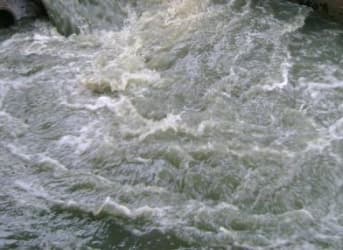Scientists estimate that over 1 trillion gallons of water will be needed for hydraulic fracturing, or fracking, to recover shale gas worldwide over the next half-century. But researchers from Rice University in Houston say simple recycling of this tainted waste water is by no means the answer.
Shale gas is trapped in formations of rock miles below the Earth’s surface and fracking so far is the only method of harvesting it. Besides, the process is quick and inexpensive: Water and several additives are injected under high pressure into the rock to break the shale formations, allowing access to the gas.
The downside is the quantity of water needed for the process and nature of the additives. These chemicals in the fracking waste water include hydrocarbons, fats and biological matter that are unsuitable for reuse without some form of treatment. And because it may be toxic to water-borne organisms, it can’t simply be disposed of into groundwater and rivers.
Two scientists at Rice, Andrew Barron and Samuel Maguire-Boyle, have concluded that the only solution is to apply environmentally friendly treatments to the waste water, and the best way to do that is to identify the contaminants it holds and physically remove them.
Their analysis of waste water from three fracked gas formations in Pennsylvania, Texas and New Mexico found first that recycling rather than disposal of the waste water could calm fears of accidental spills and lead to the re-use of millions of gallons of fresh water each year.
Further, he said, the amount of water used by energy companies for fracking could mean the waste of up to 5.6 million gallons a year in the Texas portion of the Haynesville shale and 2.8 million gallons at the Eagle Ford formation in South Texas. Those amounts alone, Barron says, can be a burden on neighboring communities.
As for identifying the contaminants, they include matter such as dissolved salt from sea water that was trapped underground a long as 200 million years ago, according to Barron and Maguire-Boyle’s research published in the Royal Society of Chemistry (RSC) journal Environmental Science: Processes and Impacts.
The current treatment of waste water involves halogen containing oxidants to eliminate bacteria. But the oxidants can lead to toxic reactions, making this solution less than optimal. Instead, Barron recommends relying more on physical methods and less on chemical methods. In other words, separating the contaminants from the water rather than chemically changing them.
Normally, such research elicits defensive and sometimes angry responses from the energy industry. Not so with at least one representative, George King, an engineering adviser for Apache Corp., a fracking company. He praised the Rice study, specifically the sampling and analysis methods.
“I believe industry can benefit from working with academia to find fit-for-purpose solutions to recycling produced waters from fracturing,” King told RSC’s Chemistry World.
By Andy Tully of Oilprice.com



















The threat to water supplies is real. Andy, I wonder if the water usage quoted per year for Haynesville and Eagle Ford is actually... per well:
"Further, he said, the amount of water used by energy companies for fracking could mean the waste of up to 5.6 million gallons a year in the Texas portion of the Haynesville shale and 2.8 million gallons at the Eagle Ford formation in South Texas."
My understanding is that the average usage per well is several million gallons.
Another news source adds up all the water used daily for fracking:
Every day in the United States, at least 2 billion gallons of fluids are injected into over 172,000 wells to enhance oil and gas production, or to dispose of fluids brought to the surface during the extraction of oil and gas resources.
Pasted from
http://www.forbes.com/sites/peterdiamandis/2014/09/02/solar-energy-revolution-a-massive-opportunity/